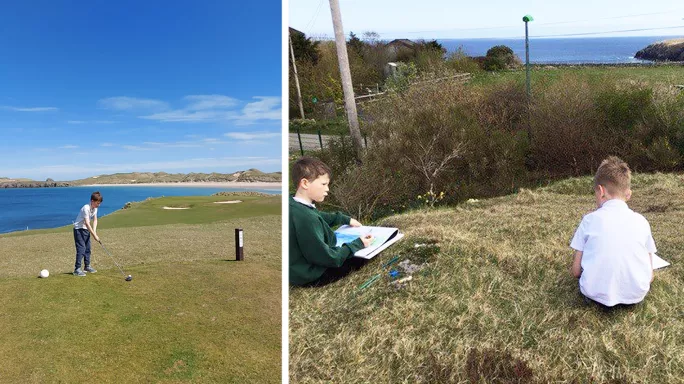How do you recruit a teacher to a four-pupil school?

Recruiting to a school with just four pupils in the far north of Scotland is not easy. The hunt for a new Durness Primary teacher - a full-time, permanent post - had to be extended when no one was appointed following the initial deadline for applications before Christmas.
The appeal of teaching in a place like this, just off the famous North Coast 500 road route, is clear, but so are the challenges.
John Naples-Campbell is the school’s headteacher, a role he also fulfils for two other primary schools (both of which have about 20 pupils), a secondary and two nurseries, over an area he describes as “pretty huge - the whole of the north-west of Scotland, basically”.
He has only been in the job since August, having previously spent the bulk of his career in urban secondary schools, so knows well what awaits anyone seeking to relocate to the area.
Durness is a village of about 400 people, two and a half hours’ drive from Inverness, five from Edinburgh and 12 from London.
And, while there are many concerns about a lack of secure teaching jobs in Scotland, it can be hard - even for schools far closer to Edinburgh and Glasgow - to tempt teachers away from the central belt, where about 80 per cent of Scotland’s population resides. Naples-Campbell found during his time in Aberdeen that many people were unwilling to relocate to Scotland’s third-biggest city, let alone a place like Durness.
Using the rural landscape
Highland Council has underlined that, with only four pupils, Durness Primary needs “a teacher that loves to think outside the box” and who is adept at “using the rural landscape to inspire young people”.
“We’ve got to be very creative with our curriculum,” says Naples-Campbell. “As a new headteacher to the area, it’s been eye-opening, having worked in Edinburgh, Glasgow and Aberdeen, to come up to a really rural part of Scotland and actually see the challenges that we’re faced with up here. It’s about giving the same curriculum opportunities that our young people get elsewhere.”
Naples-Campbell will offer the support he can, but it is 26 miles from Durness Primary to Scourie Primary - an hour in the car on single-track roads - and it takes two hours to get round the four schools and two nurseries from his main base at the 34-student, 14-teacher (or eight full-time equivalent) Kinlochbervie High. Pupils move round, too: each Thursday, primary children have a “transition day” when they work with secondary staff and students.
- Long read: Is this the way to get teachers into Scotland’s rural schools?
- Podcast: What’s it like being head at the UK’s most remote school?
- Revealed: The “most scenic school” in Scotland
The school’s four pupils are in P1, P2, P4 and P6, so there are very different levels to contend with. However, challenging behaviour issues are “non-existent” and there is plenty of time to focus on individual needs and see the subsequent impact play out over the years that follow.
“You’ve got such a wide range of ages that you need that kind of earth mother or father who is going to look after the child,” says Naples-Campbell. “But also you want someone who’s going to build their resilience and challenge them to have a look at the world they’re living in, to show them how to use their voice, and not be afraid to put the textbook down and explore.
“You’ve got to be a teacher who’s able to take their own initiative, to look at the community and make the curriculum relevant to it - so a lot of outdoor learning, project-based learning and group work, but also giving each of the pupils the individual focus that they need.”

The role - applications for which close on Monday, 22 January - requires a decent amount of teaching experience, says Naples-Campbell, especially of working in a rural school. Pupils should feel that the school is connected to the crofting community that has sustained generations of Highland families, and to other “industries that make that area liveable” - such as travel and tourism, hospitality, working with animals, working with art and “being creative” - while also equipping them for emerging 21st-century jobs and skills.
Romanticised image
Vacancies in schools like Durness - and there are many in Scotland - often attract the attention of national media outlets, but they can project an overly romanticised image of what the job entails. A flurry of applications may follow, but the candidates are often unsuitable and some do not even have a teaching qualification.
“When you drive into the area, you are dodging sheep right, left and centre [but] it’s breathtaking: when I’m driving up to the school, I’m literally stopping my car and just taking deep breaths and looking at the beautiful scenery,” he says.
However, loneliness is a potential issue, cautions Naples-Campbell, and if you’re in the wrong mood, the largely treeless landscape of moors and forbidding hills could take on a desolate air. Durness itself, besides the school, has a shop and a garage. Then there’s the beach which, on a good day, has a view of the Atlantic with the Hebrides jutting around the horizon. Nearby is a huge live firing range used by the military, the location chosen presumably because of the dearth of people round these parts. The Twitter account for the six North West Sutherland Schools, as they are collectively known, proclaims “welcome to education at the edge of the world!”
“It’s a really complicated, challenging post - not something that’s going to suit everybody - but also a very exciting one,” says Naples-Campbell. “I’m a city boy who never thought I’d find myself up here, but I just fell in love with it.”
He has found that the community belies numerous stereotypes about rural living.
“The people are lovely, very, very welcoming, and I’m saying this as a gay man who has had a lot of abuse [elsewhere and] was absolutely petrified - I couldn’t have asked for a nicer welcome.”
The problems of rural depopulation are a constant concern for communities in the Highlands - the roll of Kinlochbervie High, while 34 now, has been as high as 100 in the past - but Naples-Campbell has not found Durness to be a tired, downtrodden place. “The young people are just full of life,” he says, often zipping about on quad bikes, or heading out to surf and paddleboard. Adults keep busy at an arts hub, dance classes, a choir and a plethora of good restaurants within driving distance - “There’s always something going on.”
Housing conundrum
While recruits to the area can expect a relocation package on top of their salary, and many will relish the chance of a slower pace of life and better work-life balance, one of the biggest barriers for potential applicants is housing - or the lack of it. One part-time colleague spends two nights a week in a campervan while working in the area, for example.
Finding jobs for partners can be hard, too. Naples-Campbell’s husband lives with him from Monday to Thursday, then makes the five-hour round trip to Inverness where he works as a figure-skating coach at weekends.
The new teacher at Durness can expect to see both Naples-Campbell and his depute head a couple of days a week, and they can network with the wider “campus” of schools, but they will often be physically on their own - so the challenge is to recruit someone who might feel more liberated than daunted by this.
“You’re in charge of your monitoring and tracking [at Durness Primary], you’re in charge of your attainment levels and I’m trusting you, that when you’re deciding your curriculum, you know what you’re doing,” says Naples-Campbell, who has a secondary teaching background.
“My job is asking you challenging questions to make sure that the curriculum is robust - but you’re the primary specialist.”
Freedom to innovate
One way of attracting the right candidates is to sell them on the idea that schools like these can be a hotbed of curricular innovation.
“What I love about this school, and our campus more generally, is that we are creating our own curriculum to suit the needs of our young people,” says Naples-Campbell. “So rural skills are going to be a huge part of our curriculum as of next year, as well as hospitality, travel and tourism, and childcare.”
The difficulty in recruiting to places like Durness suggests it takes a bold, even exceptional, character to work in such schools - someone willing to take a risk, but in the knowledge that there could be the reward of a teaching experience like few others.
For the latest Scottish education news, analysis and features delivered directly to your inbox, sign up to Tes magazine’s The Week in Scotland newsletter
You need a Tes subscription to read this article
Subscribe now to read this article and get other subscriber-only content:
- Unlimited access to all Tes magazine content
- Exclusive subscriber-only stories
- Award-winning email newsletters
Already a subscriber? Log in
You need a subscription to read this article
Subscribe now to read this article and get other subscriber-only content, including:
- Unlimited access to all Tes magazine content
- Exclusive subscriber-only stories
- Award-winning email newsletters



